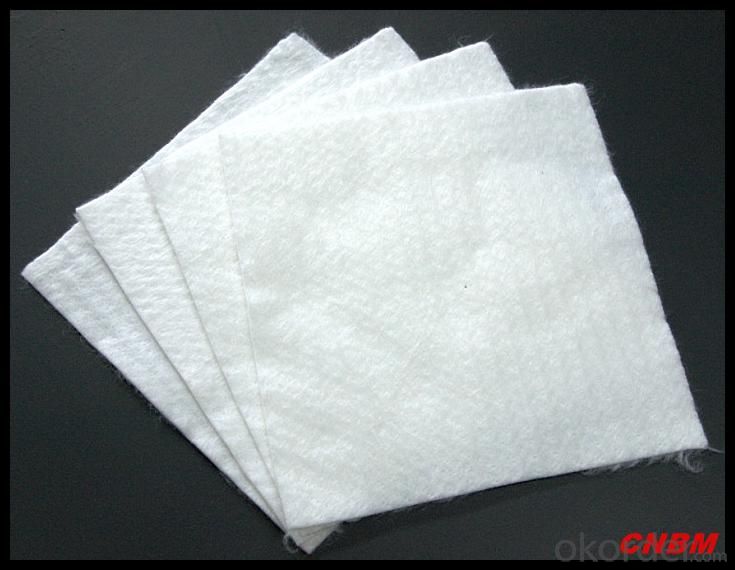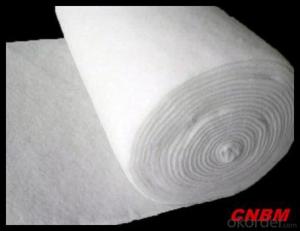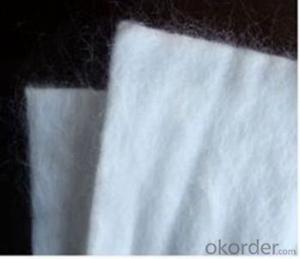Non woven Geotextile VS Woven Building Material Fabric
- Loading Port:
- China main port
- Payment Terms:
- TT OR LC
- Min Order Qty:
- 2000 m²
- Supply Capability:
- 500000 m²/month
OKorder Service Pledge
OKorder Financial Service
You Might Also Like
Item specifice
non woven geotextile vs woven Building material fabric
Products Description
We manufacture quality Nonwoven geotextiles from polypropylene/ polyester staple fibers, which are mechanically bonded through needle-punching to form a strong, flexible and dimensionally stable fabric structure, with optimum pore sizes and high permeability.
---non woven geotextile vs woven Building material fabric---
Advantages:
-High Performance
-High water & gas permeability nonwoven geotextile
-High tensile strength & tearing resistance
-Aging resistance
-Anti-corrosion nonwoven geotextile
----non woven geotextile vs woven Building material fabric----
Product Features
1.Excellent drainage performance
2.High strength,excellent tenacity
3.Anti-aging,anti-acid and alkali
4.Can accommodate irregular deformations
5.Creep, corrosion and abrasion resistance
6.Safe and easy for construction
---non woven geotextile vs woven Building material fabric--------
Application Range
| Non-woven Geotextile are used for | |
| Subsurface drainage | |
| When the roads are constructed in the areas of saturated soils; this water damages the asphaltic pavement. When the non-woven geotextiles are used as a drainage layer in the sub grade, they act as a drainage path to for the water coming from below to drain it off in a side drain. Thus the water is not allowed to come in contact with the asphalt layer thus avoiding its damage by water. | |
| Roadway separation | |
| The non-woven geotextiles act as a separator between the layers of the sub grade. Thus protecting the small aggregates penetrating the sub base and avoiding the deformation of the pavement. | |
| Railway Stabilization | |
| Hard armour underlayment | |
| Asphalt overlay | |
| Geomembrane protection | |
| Gas venting | |
| Drainage systems | |

Packaging & Shipping
Packing: PLASTIC FILM INSIDE, AND WOVEN BAG OUTSIDE
Shipping: About 15 days after receipt the deposit
pecifications
geotextile fabric
permeability,filtration,easy for construction
ISO and CE certificate
Good quality and competitive price
Our Service
Quality assurance
1.On a regular basis or as per your request,we entrust national testing agencies to conduct quality inspections
2. Strictly in accordance with the ISO9001-2008 international quality system standard,we monitor and manage the whole process throughout production,quality testing,and measurement to ensure product quality
3. For quality-related construction delay or substandard construction(except for damage or losses due to customer’s responsibility or irresistible natural disasters),we have refunding,replacement,and repair services.We will respond to customers’ feedbacks on quality issues within 24 hours.
After-sales service
1.In order to provide customers with comprehensive technical support,we will provide technical and other related information upon request in a timely manner.
2.In required,we will appoint specialized technicians to the construction site to give technical trainings to construction people,and offer technical guidance throughout the whole construction process.
3.For damage due to shipment and delivery,after we receive the complaint,we will check the issure through provided pictures and videos.If our responsibility is confirmed,we wil offer free replacement.
4.When the construction is completed,as your request,our technical staff may participate in the final acceptance.
FAQ:
Q: What kind of payments does jenor support?
A: T/T, L/C, Cash are accepted.
Q: Do you charge for the samples?
A: Accordeing to our company policy, the samples are free, we only charge the freight fee. And we will return the freight fee during the next order.
Q: Can you produce according to customers' design?
A: Sure, we are professional manufacturer, OEM and ODM are both welcome.
Q: Do you have other products?
A: Yes, please check the pictures:
- Q:Can geotextiles be used in geosynthetic clay liners?
- Yes, geotextiles can be used in geosynthetic clay liners. Geotextiles are often used as a component in geosynthetic clay liners to enhance their performance by providing separation and filtration functions. They help to prevent the migration of fine particles and offer additional reinforcement to the clay liner.
- Q:What are the factors to consider when designing geotextile-reinforced walls?
- When designing geotextile-reinforced walls, there are several factors that need to be considered. Firstly, the strength and stability of the geotextile material itself is crucial. The geotextile should have sufficient tensile strength and durability to withstand the loads and pressures exerted on the wall. Secondly, the soil characteristics and properties must be thoroughly analyzed. Factors such as soil type, compaction, and shear strength are essential in determining the design of the reinforced wall. The slope of the site and the anticipated slope stability also play a significant role. The angle of inclination and the height of the wall will impact the design and reinforcement requirements. Additionally, proper drainage is vital to prevent water buildup and potential failure of the wall. The design should incorporate adequate measures to ensure effective water management and prevent hydrostatic pressure. Considering the environmental conditions is essential. Factors such as temperature variations, freeze-thaw cycles, and corrosive substances in the soil must be taken into account to ensure the longevity of the geotextile-reinforced wall. Lastly, construction techniques and maintenance requirements should be considered during the design phase. The ease of installation, access for maintenance, and potential future repairs should all be evaluated to ensure the practicality and sustainability of the reinforced wall.
- Q:Geotextile what is the law?
- Geotextile, also known as geotextile, it is made of synthetic fiber through acupuncture or woven from the permeability of geosynthetics. The American Society of Agricultural Engineers defines geotextiles as geotextiles or geosynthetics that exist between soils and pipelines, gages, or retaining walls that enhance water movement and impede soil movement. ASTM 4439 standard geotextile is defined as: a purely permeable geosynthetics to form textiles. Is used in soil, rock, soil or other geotechnical engineering related materials and acts as a component of a human-made project. Geotextile is a new type of building materials, raw materials are polyester, polypropylene, acrylic, nylon and other polymer polymer synthetic fiber. In accordance with the manufacturing method is divided into: there are two types of geotextile and non-woven geotextile. General engineering is mainly used non-woven geotextile. Geotextile with filter, filter, isolation, reinforcement, protection, sealing and other functions.
- Q:What are the advantages of using geotextiles in green roof design?
- There are several advantages of using geotextiles in green roof design. Firstly, geotextiles help to retain water in the soil, preventing excessive runoff and reducing the strain on drainage systems. Secondly, they provide a protective layer that prevents roots from damaging the waterproofing membrane of the roof. Additionally, geotextiles can improve the stability and structural integrity of the green roof by preventing soil erosion and promoting even distribution of water and nutrients. Lastly, geotextiles can aid in weed control, reducing the need for herbicides and maintenance. Overall, incorporating geotextiles in green roof design enhances the functionality, longevity, and sustainability of the green roof system.
- Q:Seepage geotextile symbol
- I produce geotextile materials
- Q:Geotextile need to adjust the humidity before sampling, what does this mean
- probably. For the first time I heard that geotextiles were sampled to be wet.
- Q:What are the different geotextile installation techniques for landfill applications?
- There are several geotextile installation techniques commonly used for landfill applications. These include the direct placement method, the trench method, the soil cover method, and the liner method. The direct placement method involves placing the geotextile directly on the subgrade or waste material, while the trench method involves placing the geotextile in a trench and then covering it with soil. The soil cover method involves placing the geotextile on top of the waste material and then covering it with a layer of soil. The liner method involves placing the geotextile on top of a geomembrane liner to provide additional protection and support. Each method has its own advantages and considerations depending on the specific requirements of the landfill site.
- Q:How do geotextiles enhance drainage systems?
- Geotextiles enhance drainage systems by providing filtration and separation, allowing water to flow freely while preventing soil particles from clogging the system. They also help in soil stabilization and erosion control, improving the overall efficiency and longevity of the drainage system.
- Q:How do geotextiles improve the performance of retaining walls?
- Geotextiles improve the performance of retaining walls by providing reinforcement and stability to the soil behind the wall. They prevent soil erosion and retain moisture, reducing the potential for settlement and slope failure. Additionally, geotextiles act as a filter, allowing water to drain while preventing the migration of fine particles, thus preserving the structural integrity of the retaining wall.
- Q:Can geotextiles be used in geosynthetic clay liner applications for containment systems?
- Yes, geotextiles can be used in geosynthetic clay liner applications for containment systems.
1. Manufacturer Overview |
|
|---|---|
| Location | |
| Year Established | |
| Annual Output Value | |
| Main Markets | |
| Company Certifications | |
2. Manufacturer Certificates |
|
|---|---|
| a) Certification Name | |
| Range | |
| Reference | |
| Validity Period | |
3. Manufacturer Capability |
|
|---|---|
| a)Trade Capacity | |
| Nearest Port | |
| Export Percentage | |
| No.of Employees in Trade Department | |
| Language Spoken: | |
| b)Factory Information | |
| Factory Size: | |
| No. of Production Lines | |
| Contract Manufacturing | |
| Product Price Range | |
Send your message to us
Non woven Geotextile VS Woven Building Material Fabric
- Loading Port:
- China main port
- Payment Terms:
- TT OR LC
- Min Order Qty:
- 2000 m²
- Supply Capability:
- 500000 m²/month
OKorder Service Pledge
OKorder Financial Service
Similar products
New products
Hot products
Hot Searches
Related keywords
































